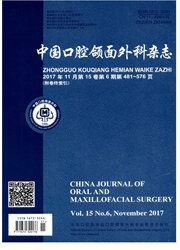

 中文摘要:
中文摘要:
目的:基于锥形束CT(CBCT)资料建立有限元模型,预测正颌术后三维软组织形变,探讨该方法的可行性与准确性。方法:选取下颌前突患者2例,于术前行颅颌面CBCT扫描,导入Mimics10.01软件,进行软、硬组织三维重建。采用Geomagic Studio11软件进行模型处理,并按实际情况进行手术模拟截骨,导入有限元分析软件AnsysWorkbench 11.0,建立线弹性有限元模型,加载位移后,经分析得出术后软组织三维模样,将其与术后6个月及以上的软组织三维重建图像对比,并进行定性及定量评价。结果:2例患者CBCT资料顺利进行有限元建模及预测,临床定性评价显示2例患者预测结果总体观察相似度高,但在口周及颊部相似度欠佳;Geomagic Qualify11定量检测显示,病例1误差小于2mm的区域为94.98%,病例2误差小于2mm的区域为90.71%。结论:采用线弹性有限元模型预测下颌前突正颌术后的软组织形态是可行的,可为临床提供较为可靠的参考。
 英文摘要:
英文摘要:
PURPOSE: In the field of orthognathic surgery,both the doctors and patients are worry that how the new facial outlook would be like after surgery.In this study,a new technique for three-dimensional(3D)facial soft-tissue-change prediction after surgery was established and evaluated preliminarily.METHODS: Two patients with mandibular protrusion were recruited in this study.First a linear finite element model based on cone beam CT(CBCT) scans of the patients before surgery was developed,and the model was used to calculate the soft tissue deformations after virtual surgical simulation.Then the prediction results were compared with the 3D reconstructed CBCT models of the patients 6 months after surgery qualitatively and quantitatively.RESULTS: At last,the soft tissue deformations of the two patients were successfully predicted with the finite element method.From a clinical point of view,the prediction results were generally consistent with the operation results except some regions,around the lip and cheek.We measured the prediction error with Geomagic Qualify 11.For 94.98% of the skin surface,the prediction error was below 2mm in the first case,and 90.71% in the second case.CONCLUSION: Finite element method is proved to be feasible in soft tissue deformation prediction after BSSRO,which would provide reliable imformation for clinical references.
 关于曾融生:
关于曾融生:
 同期刊论文项目
同期刊论文项目
 同项目期刊论文
同项目期刊论文
 期刊信息
期刊信息
